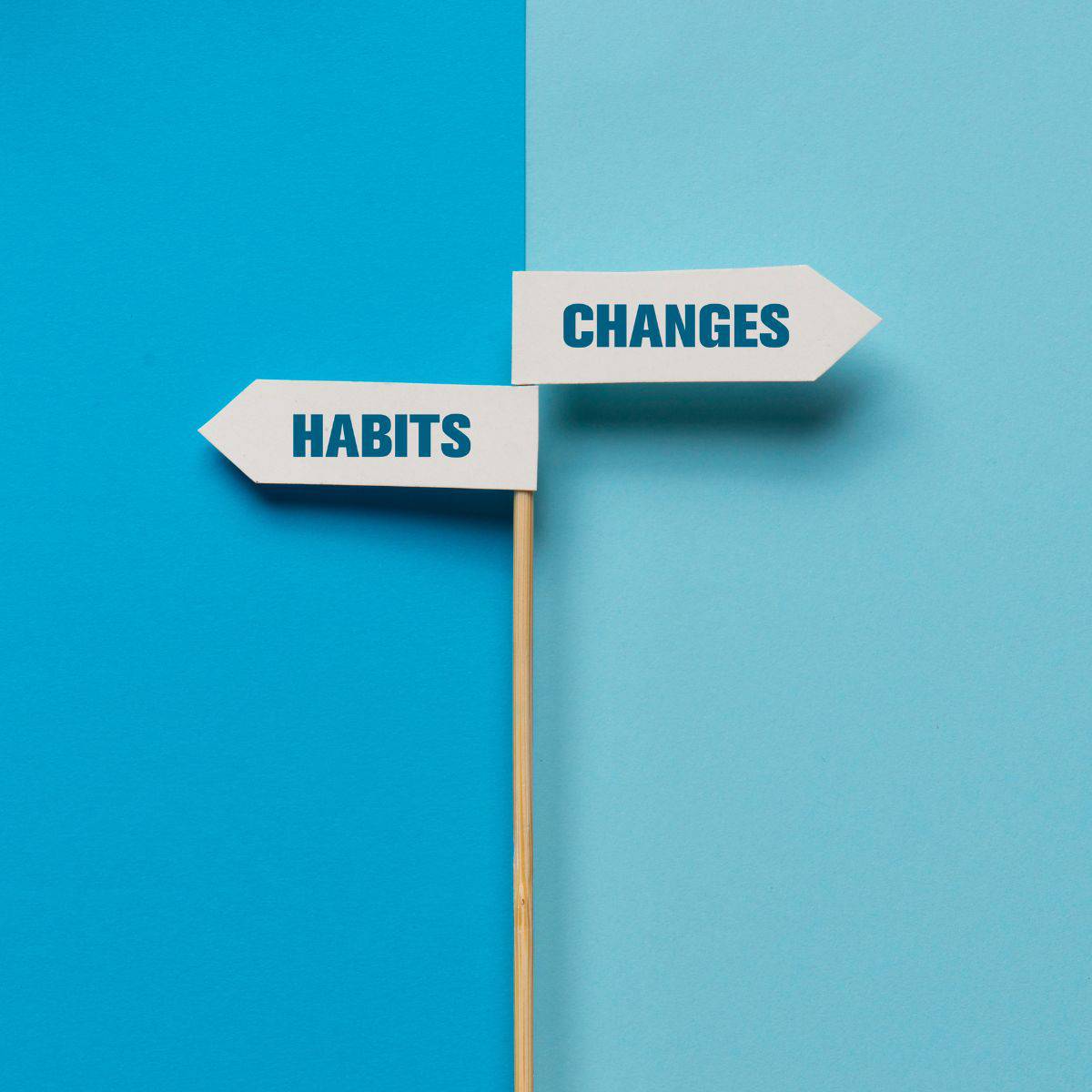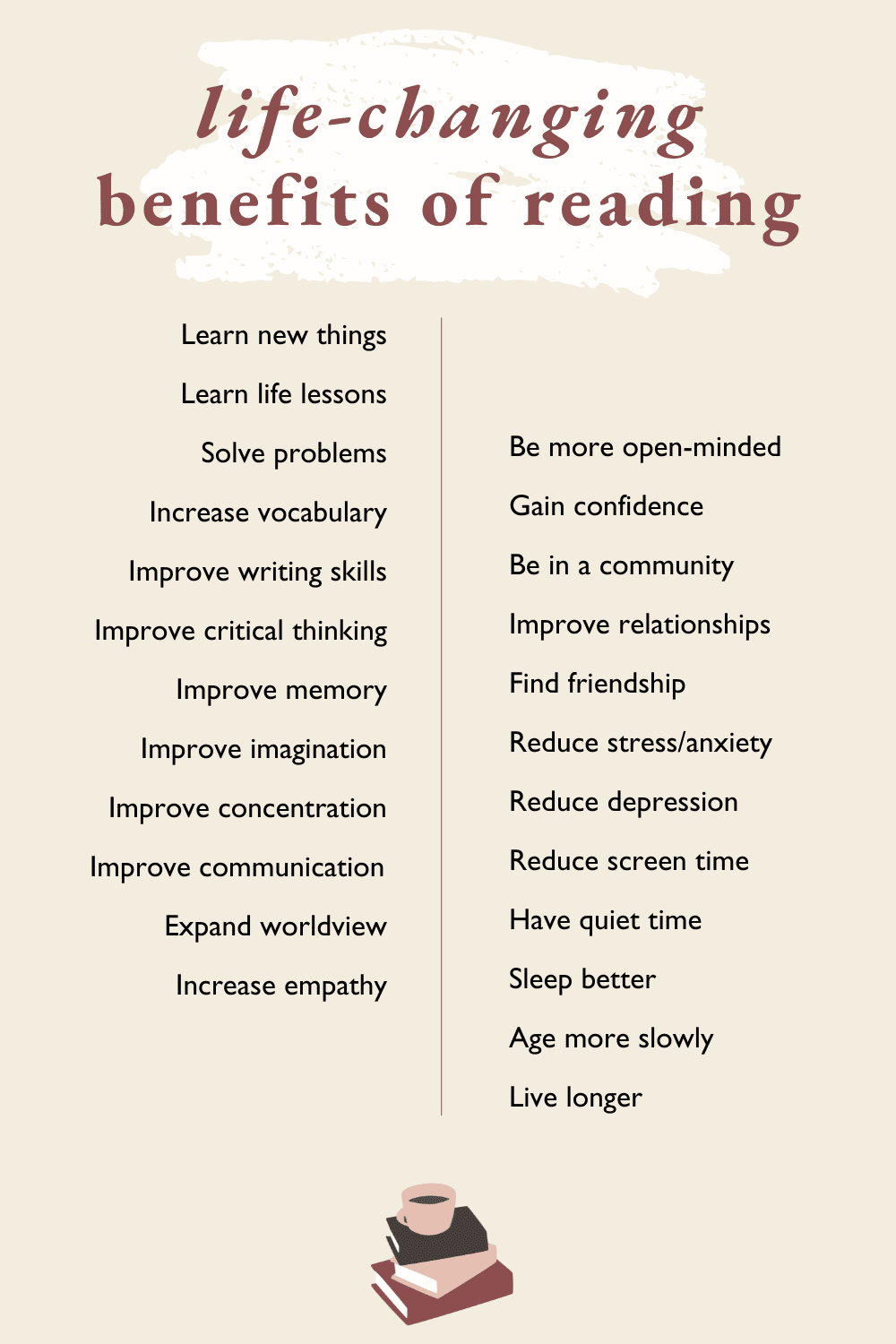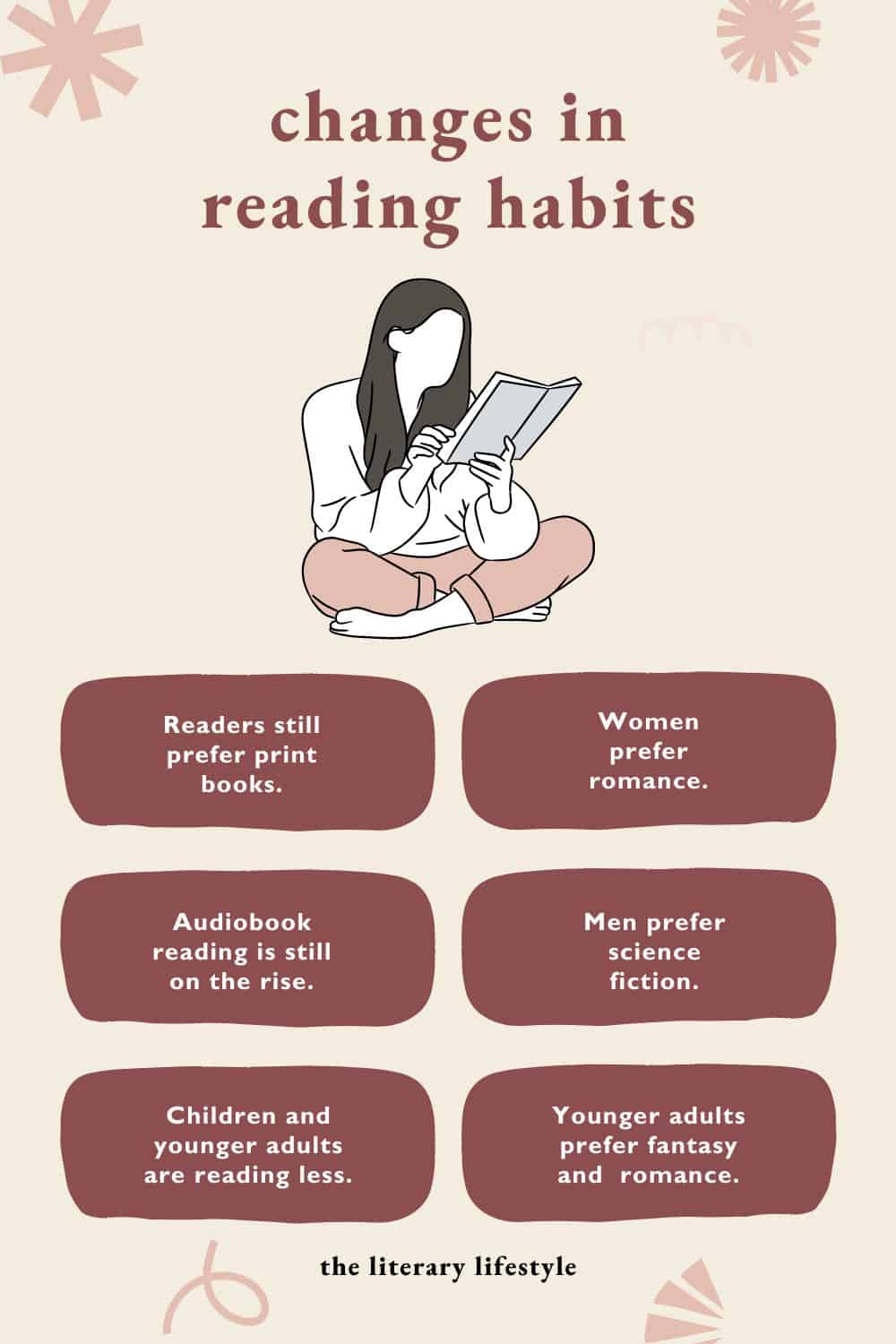Discover the truth about the changes in reading habits of adults in the United States, some of which may surprise you! It’s not just intriguing what my research revealed — it’s also impactful, especially as to younger generations.

It’s no secret that the benefits of reading include, among other things, increased communication skills, empathy, and even mental and physical well-being.
Still, if you “count” audiobooks, about 33% of American adults read 0-1 book a year (YouGov), and if you don’t count audiobooks, nearly 52% of American adults don’t finish even 1 book per year (WordsRated).
Further, according to ThinkImpact, in 2023, 21% of American adults are illiterate.
So, it’s clear that reading habits currently aren’t that great in America. In order to understand how we got here (and how we can hopefully improve), it’s important to first look at changes in reading habits.
Naturally, this includes technological advancements, but beyond these societal changes, personal characteristics such as age, gender, politics, and income contribute to changes in reading habits.
It’s incredibly complex to unpack both reading habits and literacy in America, and no one article, or even a series of articles, may unpack it all. My intent here is simply to point out some of the ways in which technology, age, gender, politics, and income have changed the reading habits of Americans.
Changes in Reading Habits
Evolution of Reading Habits
Takeaways:
- Digital technology and the rise in banned books have changed (and will likely continue to change) reading habits, particularly in the United States.
We can’t talk about changes in reading habits without first acknowledging the evolution of reading habits.
The art of reading has undergone a radical transformation in the last few decades. For example, the advent of digital technology has influenced how we consume words, and the proliferation of banned books in recent years has changed what books are read (or not read) in high schools.
Of course, traditionally, reading was something done in a print format: books, magazines, and newspapers. And, generally, readers were limited to obtaining them at libraries and bookstores. Now, we also consume content digitally via ebooks, audiobooks, videos, podcasts, blogs, and social media.
And, while the number of books “banned” in the United States remained under 400 every year from 2000 to 2020, the number rose to 1,858 in 2021 and 2,571 in 2022, according to the American Library Association.
These evolutions in technology and politics both impact the changes in reading habits discussed below, in sometimes surprising ways.
Technology’s Impact on Reading Habits
Takeaways:
- Ebook sales rose sharply when tablets were released, then sales calmed down.
- Readers still prefer print books to ebooks.
- Audiobook reading has been generally on the rise over the past 10+ years.
- Older Americans ages 65+ read more books both when they were younger (pre-digital technology) and now (post-digital technology).
- Higher-income households read more books.
As mentioned, technology has greatly impacted reading habits over recent years.
Between 2010 and 2012, ebook sales rose sharply and print book sales dropped sharply, according to WordsRated. However, in the decade afterward, print book sales rose a bit and ebook sales dropped a bit. Today, 4 print books still sell for every 1 ebook.
The sharp changes in 2010-2012 may be attributed to the 2010 release of Apple’s iPad, which had a built-in app for e-book reading as well as a bookstore. In 2011, the first Android-based tablets, as well as LCD tablet versions of the Nook and Kindle e-readers, were released.
So, it seems after the initial buzz of a “shiny new object” died down, readers continued to incorporate ebook reading into their lives but also returned a bit more to traditional print reading.
Why? A few things I’ve experienced myself as an avid reader and heard from others in the reading community include the desire to reduce screen time, the fun of collecting books and taking photos of them for social media, and the greater ease of sharing, selling, and trading print books online.
That being said, audiobook sales generally climbed steadily upward in recent years:
| Year | Percentage of U.S. Adults Who Listened to an Audiobook in the Year Prior |
|---|---|
| 2011 | 11% |
| 2021 | 23% |
Why? A few things I’ve experienced myself as an avid reader and heard from others in the reading community include the ease of consuming audiobooks, especially during mundane tasks like commuting to work or exercising. They also make reading more accessible to different types of learners.
It’s also important to note that the rise in content on blogs, podcasts, and social media may also contribute to changes in reading habits. (Of course, other factors, like time and financial constraints, may also contribute.)
For example, according to YouGov, while high rates of middle-aged to elder adults in the United States read books when they were younger and these technologies didn’t exist (93-95% of adults age 45 and over read books then), fewer younger adults read books when they were younger and these technologies were growing in popularity (79% of adults 30 and under).
Further, YouGov reports that, as of 2022, the age group in the United States that may be said to use digital technology the least (age 65 and over) accounts for 30% of all adults who read the most books per year (11-20+ books).
It should also be noted that the cost of digital technology may have impacted changes in reading habits. Today, according to YouGov, while 22% of adults in the United States did not read a book even partially in the year prior to the 2022 study, this number dropped to 17% in households earning over $100,000.00 per year. One reason may be that, while books are more accessible, they may be deemed less affordable.
Reading for Education vs. Entertainment
Takeaways:
- Most educational reading has decreased as American adults aged, except religious reading.
- Today’s adults prefer mystery and crime, history, biographies and memoirs, religion and spirituality, and thrillers.
- Today’s men like science fiction more than women, and women like romance novels more than men.
- Adults under age 30 prefer fantasy and romance at higher rates.
- Adults ages 65+ prefer mystery and crime at higher rates.
The purpose of reading can generally be described as for educational value or for entertainment value. There have also been changes in reading habits over time for these purposes.
Of adult Americans who read both when they were younger and now, these are the differences in educational genres read:
| Genre | Percentage Who Read It Then | Percentage Who Read It Now |
|---|---|---|
| History | 39% | 27% |
| Literary Fiction | 29% | 16% |
| Academic | 24% | 11% |
| Other Non-Fiction | 20% | 17% |
| Religion and Spirituality | 19% | 20% |
Of all genres considered more educational in nature, only religious reading grew (ever so slightly) as American adults aged, whereas all other educational reading decreased.
I’m not surprised to see that “other non-fiction” educational reading dropped the least since it would include popular self-help, health, and business reading.
But, I am disappointed to see literary fiction reading drop in half since there is so much to be gained from reading books like the classics, despite them being “harder” to read.
As of 2022, according to YouGov, adults in the United States preferred reading these five genres:
- mystery and crime
- history
- biographies and memoirs
- religion and spirituality
- thrillers
As someone who writes about books on a daily basis, this generally doesn’t surprise me, but it feels a bit male-leaning in preference. Most women I know generally don’t read history or biographies, whereas many men I know do so.
YouGov reported that, generally, men and women enjoyed the same genres at similar rates, except men liked science fiction more than women and women liked romance more than men.
There are also changes in the reading habits of younger Americans:
- Adults under age 30 prefer fantasy and romance at higher rates than older Americans.
- Adults age 65 and older prefer mystery and crime at higher rates than younger Americans.
This is totally in line with what I see and hear as a book blogger, and it doesn’t surprise me at all. For example, TikTok (used most heavily by younger adults), contributed to a huge spike in the sales of romance books in recent years.
Changes in Children and Young Adults’ Reading Habits
Takeaways:
- Younger adults are reading less when they are younger.
- Far more books are being banned.
As mentioned already (but it bears repeating), fewer young adults report having read books when they were younger (79% of American adults 30 and under, versus up to 95% of older Americans).
What’s more is that American children are reading for fun less often, according to Pew Research Center:
| Age | Year | Percentage Who Read Books for Fun Almost Daily |
|---|---|---|
| 9 | 1984 | 53% |
| 9 | 2012 | 53% |
| 9 | 2020 | 42% |
| 13 | 1984 | 35% |
| 13 | 2012 | 27% |
| 13 | 2020 | 17% |
(Likewise, the percentage of children who said they read never, hardly ever, or less frequently generally grew steadily over time.)
Since social media, to which so many children are affixed for entertainment, either didn’t exist or was far less prevalent in the earlier years studied, it likely accounts for a major reason for the reduction in their reading for fun.
Further, banned books are astronomically on the rise in the United States, reducing access to books that may interest students:
| Year(s) | Number of Titles “Banned” |
|---|---|
| 2000-2020 | under 400 each year |
| 2021 | 1,858 |
| 2022 | 2,571 |
These changes in the reading habits of children (and young adults who were recently children) are startling, given what we know about the many advantages of reading:

So, how do we instill better reading habits in children?
I can’t speak for every classroom in America, but from what I’ve seen and experienced in helping my brother-in-law secure 1,500+ book donations for a classroom library in his low-income Philadelphia area school district was not as hard as it may seem: we simply secured books that reflected the students’ diversity and interests and we made it fun and easy for the students to access them.
The rate of reading rose dramatically, and it remained at high levels for years.
Pros and Cons of New Reading Habits
To recap this brief overview of some of the changes in reading habits in America, below I’ve categorized the major takeaways from these changes in reading habits into a list of pros and cons.
Pros
- Ebook sales rose sharply when tablets were released, then sales calmed down, but still remain popular.
- Readers still prefer print books to ebooks.
- Audiobook reading has been generally on the rise over the past 10+ years.
- Older Americans ages 65+ read more books both when they were younger (pre-digital technology) and now (post-digital technology).
- Higher-income households read more books.
- Today’s adults enjoy mystery and crime, history, biographies and memoirs, religion and spirituality, and thrillers.
- Today’s men enjoy science fiction, and women enjoy romance novels.
- Adults under age 30 prefer fantasy and romance at higher rates.
- Adults ages 65+ prefer mystery and crime at higher rates.
Cons
- If you “count” audiobooks, about 33% of American adults read 0-1 book a year, and if you don’t count audiobooks, nearly 52% of American adults don’t finish even 1 book per year.
- In 2023, 21% of American adults are illiterate.
- Most educational reading has decreased as American adults aged, except religious reading.
- Lower-income households read less books.
- Younger adults are reading less when they are younger.
- Far more books are being banned.

Conclusion
Digital technology, the rise in banned books, and personal characteristics have changed (and will likely continue to change) reading habits in the United States.
For further information about reading habits, check out the posts below.
Related Reading Habits Posts
- Ultimate Guide to the Habit of Reading
- Good Reading Habits to Develop
- Bad Reading Habits to Overcome
- How to Make a Reading Habit
- Best Books to Kickstart Your Reading Habit
- Summary of Atomic Habits
- How to Apply the Reading Habits of Successful People
- Quotes About Reading Habits to Live By

